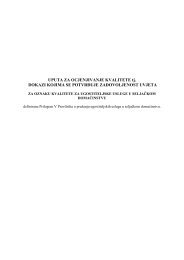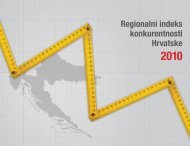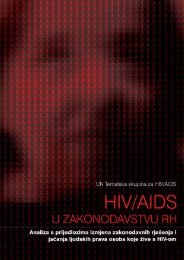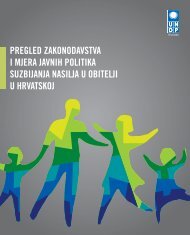WEB engleska verzija end.indd - UNDP Croatia
WEB engleska verzija end.indd - UNDP Croatia
WEB engleska verzija end.indd - UNDP Croatia
- No tags were found...
You also want an ePaper? Increase the reach of your titles
YUMPU automatically turns print PDFs into web optimized ePapers that Google loves.
CHAPTER 3THE SOCIALLY EXCLUDEDJudging by secondary school or university students, itseems that young citizens enjoy a relatively high qualityof life and social security; they are still acquiringeducation and are generally not too burdened with alack of economic indep<strong>end</strong>ence. It is this population(between 15 and 24 years of age) who report most satisfactionwith their life and are the happiest. 109 However,once young people complete their education, theyenter the labour market for the first time, and have toundergo the difficult task of looking for a suitable job.From the apparent formal and educational lethargyof the <strong>Croatia</strong>n educational system, young people arefaced with the fact that after they finish their educationthey will most likely have to wait some time beforethey can begin their profession. The unemploymentrate of people aged 15 to 24 varies from 2 to 2.5 timeshigher than the national unemployment rate. Therelative unemployment of youth places <strong>Croatia</strong> at thebottom of the European scale, even compared to theeconomically undeveloped states where the absoluteunemployment rate of youths is higher. 110According to the web portal MojPosao, 5% of thosewho participated in a survey on age discrimination inemployment 111 state that they frequently encounterannouncements for jobs that specify a minimum agerequirement. This occurs despite the fact that age discriminationin the work place is prohibited by Article 2of the Labour Act. The same research reveals that 58%of those younger than 29 years of age do not even attemptto apply. Young people have also reported theuse of improper interviewing techniques by potentialemployers who insist on asking them very personaland sometimes inappropriate questions when theyapply for a job. Young women are often forced toanswer questions regarding their marital status andfamily plans by employers who demonstrate a biasagainst employing potential young mothers.As an integral part and a supporting element of society,youth are frequently regarded as a social problem,and not as potential, as recomm<strong>end</strong>ed by the EuropeanCommission. 112 Societies are now faced withthe phenomenon of “ext<strong>end</strong>ed youth”, meaning thatyoung people live with their parents for longer periodsof time. As young people come of age, their difficultyin becoming indep<strong>end</strong>ent, as result of unemploymentand unsolved housing issues, generates furtherproblems, such as substance abuse, which viewed outof context perpetuate the misconception of youth asa social problem. Young people in general t<strong>end</strong> to be asocially excluded group due to their lack of participationin most economic, social and political aspects ofcitizenship. In some cases young men are more vulnerablethan young women since they experience higherdrop-out rates, higher rates of substance abuse, as wellas delinquency and suicide rates.3.8.2 Access to HealthcareIn general, young people t<strong>end</strong> to describe their healthto be extremely good, 113 however the main health concernsthat do arise are connected with sexually transmitteddiseases (STDs). Chlamydia has the highest rateof incidence among students, and the rate of HumanPapillomavirus (HPV) is increasing. However, HIV is lesscommon in young people, with the first reported caseof HIV in an adolescent coming only this year. Given thesignificant health risk that STDs pose to young people,the level of information available on sexual health is lessthan satisfactory, especially considering young peopleare entering into sexual relationships at younger ages.Public disagreements regarding sexual education programmesin schools certainly contributes to this knowledgegap. The Church can also complicate matters, as itprefers the promotion of abstinence as opposed to educatingyoung people about contraceptives and sexualhealth. Youth get most of their information regardingsexual health from their peers and the media, and somefrom their parents. However, over the past several yearsNGOs have intensified their programmes and activitiesaimed at informing and educating youth about therisk of STDs. The <strong>Croatia</strong>n health system is relatively accessibleto young people however it is not particularly109 <strong>UNDP</strong> (2006a.).”Research on social exclusion in <strong>Croatia</strong>: Quality of Life and the risk of social exclusion “. <strong>UNDP</strong>, Zagreb, <strong>Croatia</strong>.110 Young People in South Eastern Europe: From Risk to Empowerment, World Bank, Washington, 200484111 http://www.mojposao.net/jseeker_wiki.php?sessionId=6c171570e301d73e8e84d6bf9e155c2d&wikiName=IstrazivanjeDobnaDiskriminacija112 “A new impetus for European youth” – The White Paper of the European Commission, Adinda Dulčić (ed.), State Institute for theProtection of the Family, Maternity and Youth, Zagreb, 2002113 Only 0.6% of interviewees in the age group from 15 to 24 and 1.8% interviewees in the age group from 25 to 34 believe their healthto be poor, and only 6.3% of interviewees in the age group from 15 to 24 believe to have a long-term illness or difficulty (<strong>UNDP</strong> (2006)“Research on social exclusion in <strong>Croatia</strong>: Groups with increased risk of social exclusion - focus groups”. <strong>UNDP</strong>, Zagreb, <strong>Croatia</strong>)

















